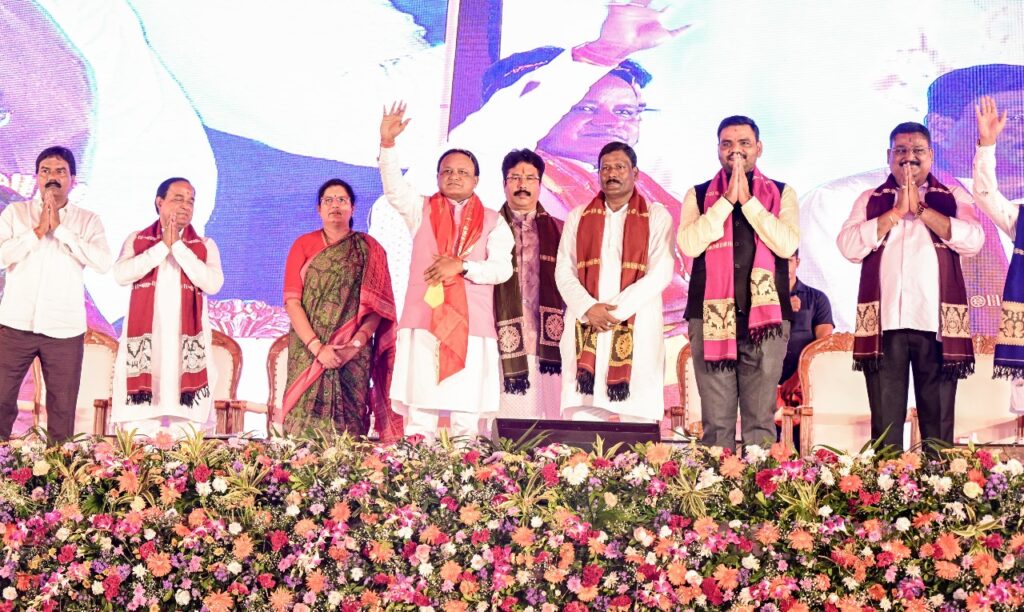As Odisha’s first BJP government completed 100 days in power on Thursday, Chief Minister Mohan Charan Majhi presented his government’s report card at a function in Puri.
Bhaskar Parichha

The BJP government in Odisha, under the leadership of Mohan Charan Majhi, concluded its initial 100 days in office on Thursday, following the end of Naveen Patnaik’s five-term leadership and the Biju Janata Dal (BJD) earlier this year. To date, the Majhi administration has concentrated on delivering on the commitments made during the Assembly elections.
Achievements
One of the first actions taken by the Majhi government, executed just a day after assuming power, was largely symbolic. The BJP reopened all four gates of the 12th century Lord Jagannath temple in Puri, three of which had been closed by the previous BJD government since the onset of the COVID-19 pandemic, resulting in significant congestion at the main entrance.
Additionally, the government allocated a fund of Rs 500 crore to promote Jagannath culture. Shortly thereafter, on June 12, a further provision of Rs 200 crore was established to support Odia art, culture, heritage, and literature.
A significant challenge for the relatively inexperienced Majhi administration arose during the first Assembly session in July. Despite a revitalized BJD, which even staged protests in the Assembly alongside the Congress, the BJP successfully navigated its inaugural Assembly session.
During the Budget presentation for the 2024-25 fiscal year on July 25, Chief Minister Majhi introduced a surprising element by retaining a majority of the “populist” initiatives from the former BJD administration. These initiatives, which enjoyed significant popularity among the populace, particularly at the grassroots level, were rebranded to eliminate their association with the BJD.
The Biju Swasthya Kalyan Yojana, which guarantees cashless medical treatment up to Rs 5 lakh (Rs 10 lakh for women), has been rebranded as the Gopabandhu Jana Arogya Yojana. The KALIA scheme, an income support initiative for farmers introduced by the Patnaik government and aligned with PM-Kisan, has been renamed CM-Kisan. Additionally, the ‘Ama Odisha, Naveen Odisha’ (AONO) scheme has been transformed into the “Viksit Gaon, Viksit Odisha” scheme.
On August 6, Majhi revealed a partnership with Niti Aayog aimed at developing a roadmap titled “Viksit Odisha @ 2036,” which aligns with Prime Minister Narendra Modi’s vision of “Viksit Bharat.”
On September 17, coinciding with PM Modi’s birthday, he visited Bhubaneswar to inaugurate the Subhadra Yojana, a program designed to support women in the state, a demographic that has been strategically nurtured by Patnaik and the BJD over the years. This initiative aims to benefit over 1 crore women aged 21 to 60 by providing annual financial assistance of Rs 10,000 for five years.
In the last 100 days, a capital investment totaling 45 thousand crores has been secured, which is anticipated to create more than 23 thousand job opportunities. The minister also outlined plans for the construction of hostels for workers and the establishment of 11 MSME parks over the next five years. The budget includes allocations for the development of FDI parks. Presently, the state is home to 16 MSME parks.
Additionally, the Majhi administration has implemented punitive actions against 58 officials, which include 17 class one and 7 class two officers. Following his announcement, the chief minister commenced addressing public grievances, thereby enhancing the government’s connection with the citizens.
Downsides
One of the significant challenges facing the government was the accusation of assault against an on-duty government official by the son of Governor Raghubar Das and his associates at the Puri Raj Bhavan during the Rath Yatra festival on July 7. Despite various protests, the government has yet to take decisive action regarding the governor’s son.
The incident involving the fall of the Lord Balabhadra idol from the chariot during the Rath Yatra festival proved to be a considerable embarrassment for the government, with the BJD seeking to hold the administration accountable. In August, the tragic reports of five fatalities in Ganjam’s Chikiti area due to illegal hooch consumption resurfaced, casting a shadow over the new government.
On August 31, Union Education Minister Dharmendra Pradhan’s proposal to rename the 156-year-old Ravenshaw University in Cuttack sparked controversy, leading to protests from alumni throughout the state. Additionally, there were reports of communal tensions in Balasore in June and Khurda in August, along with incidents of violence against women, which placed the government in a precarious position.
Promises
According to Deputy CM Pravati Parida, the state is poised to enhance the empowerment of women. Efforts are being made to improve the accessibility of government services to the public. The Chief Minister also indicated that specialized programs will be implemented across various districts and constituencies.
The government has also declared its intention to establish medical colleges in each district headquarters within the state. Initiatives to recruit lecturers for these institutions have commenced, including plans to engage retired doctors with relevant experience as educators. Additionally, there are proposals to develop four multi-modal logistics parks over the next five years, as detailed in the BJP government’s 100-day agenda.
The celebrations marking the 100-day milestone of the BJP’s administration took place at Puri Saradhabali, with Chief Minister Mohan Charan Majhi officiating the event. During the occasion, he presented this report card summarizing the achievements of the past 100 days to the public, in the presence of the State Cabinet, Union Minister, and all Members of the Legislative Assembly and Parliament.
(The author is a senior journalist and columnist. Views expressed are personal.)


























